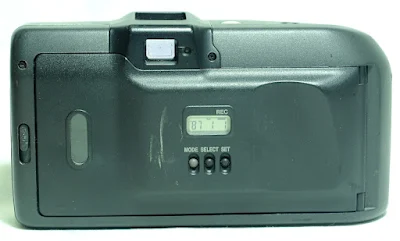As opposed to the 38mm F2.8 lens as found on the Autoboy 3, the Prisma Date comes with only a Canon 35mm F3.5 lens.
Over and above the uniqueness of the Autoboy 3, the Autoboy Prisma Date (introduced in 1988, two years after the Autoboy 3) was enhanced with a pair of features in the form of an additional Prisma finder fitted to the top plate of the camera, and a detachable infrared remote shutter release.
The addition of the Prisma finder enables the camera to be used just like a waist-level finder, shooting from the hip, or for low-level image composition.
The infrared shutter release, when placed on a flat surface and tilted slightly upward with its built-in tilt knob, makes the camera ideal for selfies or group portraits, without the need to lug a tripod everywhere you go.
Technically the Autoboy Prisma is a fully automatic autofocus 35mm compact film camera with a 3-elements in 3-groups 35mm F3.5 lens with a twin viewfinder feature, motorized film loading, and rewind, but with no mid-roll rewind function, automatic exposure coupling from 1/40 second @ F3.5 to 1/125 second @ F32, autoflash, and accepts DX-coded film with ISO speed from 50 to 1600. Non-DX-coded film rolls are rated at ISO 100.
Basic Camera Features
Although the Autoboy Prisma may look visually smaller when compared casually to the Autoboy 3, it is in fact longer by 5mm in length and thicker by 5mm in depth, and comes with a matt-black finish (at least my review unit is) with no red-line trim, and a deeper red shutter button assembly.
The front plane of the Autoboy Prisma is an array of openings and functional bits, which include, aside from the shuttered lens cover, the lens cover switch, exposure measuring window, autofocus triangulation windows, the eye-level and Prisma viewfinder windows, flash head, battery check/self-timer LED, and the slant of the shutter button assembly. The snap-in remote infrared shutter release assembly is fitted to the right shoulder of the camera front.
On the top plane, the Prisma viewfinder window is located slightly off-center to the left, and in sequence to the right, the film frame counter, self-timer switch, and shutter button.
On the backplane of the camera, the a viewfinder eyepiece, a Green LED for focus confirmation, a film back with QD setting and film window, and the film back latch to the left of the backplane.
The battery chamber cover, tripod socket, tilt knob, and remote shutter button release latch are all located on the bottom plane.
The film box is a straightforward arrangement, from left to right, of the film canister chamber, film plane window, sprocket gear, and the autoload take-up spool with film tab end location indicator. The QD battery chamber, located inside the film back, is one of the easiest to access among cameras with QD functions that I have reviewed.
Film Loading and Rewinding
Autoloading and auto-rewinding film on the Autoboy Prisma is easy and simple. All you have to do is load the film canister into the canister chamber, pull the film tab across the film frame window to the redline indicator, and close the back. The camera will automatically forward the film to frame 1, and you are ready to go.
The film roll will self-rewind once you reach the end of the roll. Just a quick reminder, though, that the Autoboy Prisma does not have the capability of mid-roll rewind, meaning that you will have to use up all the frames available on the film roll before it is wound back automatically.
Viewfinder Readouts
The eye-level viewfinder is a simple Albada-type reverse Galilean with both frame-line and autofocus spot etch, while the Prisma waist-level finder comes with an autofocus spot. The minimum recommended viewing distance of the waist-level finder is 250mm away from the eye.
Aside from the ways shown in the image on how you can make full use of the Prisma finder for overhead, waist-level, or low-level shots, one can also use the camera for right-angled spy shots. Do this by holding the camera vertically on its side with the top facing you, that is, with the lens facing to the left or right, and take the shot.
Remote Control Shooting
Another advantage you have with the Autoboy Prisma is the ability to operate the shutter button remotely, from a maximum distance of 5 meters. Set the camera up on a flat surface (or on a tripod), compose the image, unlatch the remote controller from the camera body, move to where you want your image to be captured, and use the remote to activate the camera shutter.
While the setting is active, the battery check/self-timer LED will intermittently flash continuously until it times out after eight minutes. To reactivate the setting, place the controller back in its place and repeat the sequence.
Battery and Camera Body Weight
The electronics of the camera require the installation of a 6V 2CR5 Lithium battery pack, which should last for about 35 rolls of 36-exposure film with 30% flash use. Units fitted with Date Back require the use of a CR2025 battery cell to power the date function.
The body weight of the Autoboy Prisma with Date Back and battery installed is 335 grams.






















No comments:
Post a Comment